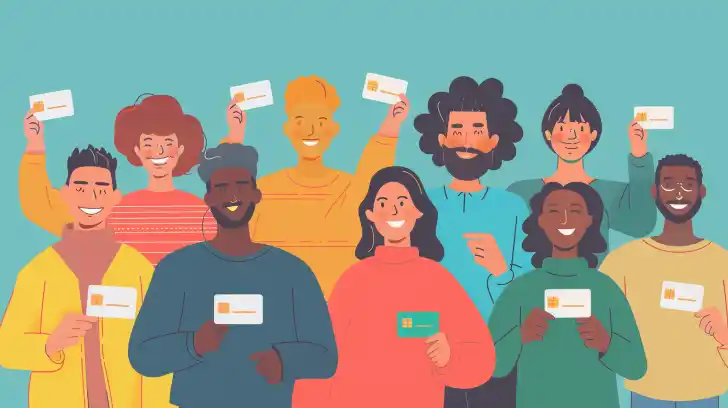Finding affordable health coverage can be tough. Luckily, nearly 7 million uninsured Americans now qualify for free insurance. This article will guide you through getting free health coverage plus a $500 bonus if you make under $50K a year.
Key Takeaways
- Nearly 7 million uninsured Americans now qualify for free health insurance through the American Rescue Plan, designed for those making under $50K. This plan can cover most of their medical costs, including a potential $500 monthly bill support.
- States like California, Colorado, and Connecticut offer additional financial help to residents earning under $50K. They provide extra stimulus checks and a special $500 bonus to ease healthcare costs.
- Misinformation about free health coverage and bonuses is widespread on social media. It’s important to use reliable sources like HealthCare.gov for accurate information. Always verify claims before sharing personal details online.
- The Affordable Care Act (ACA) marketplace has expanded options in 2024, with companies like Cigna doubling their service areas. Premium subsidies have increased, and there are higher contribution limits for Health Savings Accounts (HSAs) and Flexible Spending Accounts (FSAs), benefiting many seniors.
- Investing your stimulus check wisely can improve your financial future. Options include saving for unforeseen medical expenses in an HSA or exploring stock markets and bonds for greater returns over time.
Understanding Free Health Coverage

Understanding free health coverage means knowing you can get medical care without paying. Many people think it’s too good to be true, but it’s a real option for folks with income under $50K.
The Concept of Free Health Allowance
The American Rescue Plan offers a free health allowance to those earning less than 150 percent of the poverty level. This means the federal government could cover up to a $500 monthly bill for your health insurance if you qualify.
For many American seniors living on fixed incomes, this can significantly reduce out-of-pocket expenses for healthcare.
Eligibility hinges on personal income and participation in the Affordable Care Act‘s marketplace. If you make under $50K, chances are high you’ll benefit from these subsidies. It’s a big help for nearly 7 million uninsured Americans now qualifying for free or reduced-cost health insurance through this plan.
Misconceptions and Truths
Misconceptions about free health coverage are widespread. President Joe Biden has not announced any free health allowance or credit card for American seniors or others. Social media often spreads false news, leading to confusion among people looking for reliable healthcare options.
It’s crucial to check facts and rely on trustworthy sources, like HealthCare.gov, for accurate information.
Truth is, the Affordable Care Act (ACA) does open doors to nearly 7 million uninsured Americans for free health insurance, thanks to the American Rescue Plan. The plan also extended the enrollment period and increased funds for advertising, making it easier for those earning under $50K to get covered.
Understanding these truths helps combat misinformation and guides seniors towards securing their health coverage without falling prey to misleading promises.
American Rescue Plan and Health Insurance

The American Rescue Plan changed health insurance helped in big ways. It made it easier for people earning under $50K to afford coverage, removing previous payment caps.
The Removal of the Cap on Insurance Payments
The American Rescue Plan brought big changes to health insurance for many, lifting the limit on insurance payments. This means people don’t have to worry about paying more than a certain percentage of their income towards health coverage.
It’s especially good news for those making less than $50K, as it helps make health care more affordable.
This change is part of larger efforts to expand access and reduce costs in the health care system. Now, with no cap on subsidies, more Americans can get the help they need with their monthly premiums.
For seniors, this could mean significant savings and better access to necessary medical services without stretching their budgets too thin.
How it Impacts Those Earning Under $50K
Nearly 7 million uninsured Americans making under $50K now have a chance for free health insurance through the Affordable Care Act. This plan covers most of their medical costs. For people earning between 100 and 150 percent of the poverty level, there’s no monthly premium.
Their plan pays for 94 percent of medical expenses. This helps many save money on healthcare.
Two-thirds of uninsured Black and Hispanic/Latinx individuals in this income bracket can get zero-cost coverage too. No cap on eligibility means more folks over the poverty line get help with premiums.
This change opens doors for better health care options without stressing over high costs.
Nearly 7 Million Uninsured Americans Qualifying for Free Health Insurance
Almost 7 million Americans without insurance now have a chance to get free health coverage. This opens a new door for many to access important medical services without worry.
Criteria for Qualification
To get free health insurance under the Affordable Care Act, Americans need to meet certain income criteria. If your annual income is between 100 and 150 percent of the federal poverty level, you qualify.
This means individuals making less than $50,000 a year can access plans with no monthly premiums that cover most medical expenses. Specifically, these plans pay for 94 percent of healthcare costs.
Applying involves checking your eligibility through the health insurance marketplace during open enrollment or after significant life events that allow for special enrollment periods.
Seniors should have their financial information ready and explore options in their state to maximize benefits. For many seniors living on fixed incomes or managing chronic conditions, this can significantly reduce healthcare costs without compromising care quality.
How to Apply
Applying for free health insurance is simple. Visit HealthCare.gov or your state’s insurance marketplace by August 15. The process is straightforward, and help is available if you need it.
Make sure to have your income information ready, as this will determine your eligibility for free coverage or a $500 bonus.
For those without internet access, phone assistance is an option. Call the number listed on the HealthCare.gov website to speak with a representative who can guide you through the application over the phone.
They can also answer questions about Medicaid expansion, premium tax credits, and other benefits you might qualify for based on your income and household size.
States Providing Additional Stimulus Checks
Some states are stepping up to offer extra stimulus checks. They aim to help residents fight rising costs and improve health care access.
List of States Involved
California, Colorado, and Connecticut are stepping up for their residents. These states offer additional stimulus checks to those making less than $50,000 a year. They also provide a special $500 bonus for eligible individuals.
This move helps many manage health care costs more effectively.
Furthermore, 29 states plus the District of Columbia have expanded Medicaid under the Affordable Care Act (ACA). This expansion makes free or low-cost health insurance available to more Americans with low incomes.
It’s part of a broader effort to improve healthcare access and affordability across the country.
Misleading Promises on Social Media about Cash Allowance for Health Care
Social media is full of false promises about cash allowances for health care. Keep reading to separate fact from fiction and make informed decisions.
Fact-checking the Claims
Many posts on Facebook and Instagram claim that signing up can give you more than $5,000 for health care. These claims are not true. President Joe Biden has never announced such an initiative.
It’s important to check facts before believing these promises.
Be careful with your personal information online. Don’t share it on sites you don’t trust. Always verify information from social media before spreading it. This keeps everyone safer and better informed about their health care options.
Understanding the Reality
Some Facebook posts have been spreading false information. They say President Joe Biden offers Americans over $5,000 in cash or credit for health care. This is not true. Also, two videos on Facebook wrongly promised free awards to cover health costs.
These claims about a health credit card and a $5,200 allowance are misleading.
It’s risky to share your personal info with unknown websites that claim to offer free health care or credit cards. Only trust reliable sources for information about health insurance coverage under the Affordable Care Act and the American Rescue Plan.
These plans help uninsured people get coverage they can afford, especially those making under $50K a year.
Benefits Overview for 2024 Open Enrollment
The 2024 open enrollment period offers an array of new benefits and updates to healthcare plans, inviting a closer look for better health coverage options.
New Offerings and Changes
Open enrollment for 2024 brings exciting updates. Cigna is expanding its marketplace, doubling the number of areas where ACA plans are available. This growth makes choosing a plan more flexible for you.
Health coverage now reaches further, offering more options to fit different needs.
Along with expanded coverage choices, there’s an increase in premium subsidies. More seniors might qualify for extra help due to these changes. Also, contribution limits for Health Savings Accounts (HSAs) and Flexible Spending Accounts (FSAs) will see adjustments.
These accounts provide tax advantages on health care expenses — making it easier to manage costs throughout the year.
Medical and Dental Contribution Overview
For 2024, the Affordable Care Act (ACA) brings updates to medical and dental contributions. These changes make healthcare more reachable for American seniors. You will find more generous subsidies and an expanded eligibility range.
This means, if your income is under $50K, health insurance becomes more affordable or even free.
In detail, the ACA now allows higher contribution limits for both Flexible Spending Accounts (FSA) and Health Savings Accounts (HSA). For seniors, this is crucial as it offers a way to manage out-of-pocket expenses better.
Dental coverage has also seen enhancements, ensuring broader access to necessary care without breaking the bank. Keep these updates in mind during open enrollment to maximize your benefits.
Flexible Spending Accounts (FSA) Contribution Limits
Flexible Spending Accounts (FSA) let you set aside money before taxes for specific health care costs. In 2024, the limit on how much you can contribute to an FSA will stay at $2,850 per year.
This means you can put up to $2,850 of your pre-tax income into this account. Using this money, you can pay for things like prescriptions, deductibles, and co-pays without touching your taxed income.
If you’re married and both have access to an FSA through work, each of you can contribute up to the limit in your own accounts. This setup doubles the potential tax savings for medical expenses in a household.
Remembering these limits helps plan better for healthcare costs while reducing taxable income.
Health Savings Account (HSA) Contribution Limits
For 2024, the Health Savings Account (HSA) limits have changed. Individuals can now contribute up to $3,850. Families get a higher limit; they can put away as much as $7,750. These accounts are special because they offer tax advantages for those paying medical expenses.
Money goes in before taxes, grows without taxes, and can be spent tax-free on qualified health costs.
People over 55 get another bonus—a catch-up contribution of $1,000 on top of their usual limit. This means if you’re older and saving for healthcare costs in these accounts, your individual limit is $4,850 and family limit increases to $8,750.
Keep in mind that using these funds for non-qualified expenses could lead to taxes and penalties until you reach age 65. After that point, money can be used for any expense but may still incur income taxes if not used for qualified medical bills.
Pitfalls and Subsidies While Signing Up for Affordable Care Act Coverage
Signing up for Affordable Care Act coverage can trip you up if you’re not careful. It’s crucial to understand the difference between Medicaid and Marketplace subsidies to avoid common mistakes.
Understanding the Process of Application
Applying for health insurance under the Affordable Care Act (ACA) is straightforward. First, visit the healthcare.gov website to find your state’s marketplace. You’ll need some basic information: household size, income, and personal details of those needing coverage.
This helps determine if you qualify for free or reduced-cost insurance. If eligible, you can browse various plans and select one that fits your needs.
Next comes enrollment. After picking a plan, complete the application on the site. It guides you step by step through entering information and choosing a start date for your coverage.
Keep key documents handy—like tax returns and current health insurance cards—to make this process smoother. Once finished, you’ll get confirmation with details about how to use your new health benefits.
Medicaid Vs. Marketplace Exchange Subsidies
Medicaid offers health coverage at little to no cost for people with limited income and resources. It’s a state and federally run program ensuring that eligible seniors get access to healthcare without heavy financial burdens.
On the other hand, Marketplace Exchange subsidies help reduce the cost of health insurance premiums for those buying plans through Obamacare or ACA exchanges. These subsidies depend on your income, making insurance more affordable if you earn too much for Medicaid but still need assistance.
The American Rescue Plan has broadened the eligibility for these subsidies, ensuring more seniors can benefit from reduced-cost healthcare options. Whether you qualify for Medicaid or receive a subsidy on the healthcare exchange depends on your income level.
For individuals making under $50K, substantial savings on medical expenses are now within reach, thanks to expanded support through these programs.
COBRA Coverage as a Backup Plan
COBRA coverage steps in as a safety net for individuals who suddenly lose their health insurance. This plan gives people up to two months to decide after their employer-provided coverage ends.
It’s retroactive, which means it can cover medical expenses incurred during that decision period. Signing up for COBRA is critical for those wanting continuous protection without gaps.
It’s essential to know, selecting COBRA has significant impacts on eligibility for other benefits. Once you choose COBRA, you can’t receive ACA subsidies for the rest of the calendar year.
This information helps manage expectations and financial planning effectively, especially considering budget constraints and healthcare needs.
What to do with your Stimulus Check
Use your stimulus check wisely by exploring smart saving or investment options to secure your financial future. Keep reading for more insights.
Strategies for Effective Utilization
Invest your stimulus check wisely to support your health and well-being. Consider medical needs that aren’t fully covered by insurance, like certain dental services or physical therapy.
Placing some funds into a Health Savings Account (HSA) could also prepare you for unforeseen medical expenses down the road. This account comes with tax advantages, making it a smart place to store money for future healthcare costs.
Explore additional financial resources available through social welfare programs if your income is under $50K. Programs such as food stamps and subsidized housing can reduce living costs, allowing you to allocate more of your budget towards health care needs and savings.
Always compare options in the Marketplace Exchange and consider Medicaid eligibility for comprehensive coverage at reduced rates, ensuring you have the most beneficial plan tailored to your circumstances without overspending.
Potential Investment Avenues
Putting your stimulus check into a savings account is a safe choice, but exploring other investment avenues can offer higher returns. Think about stocks, bonds, or mutual funds for growth over time.
These options carry more risk but have the potential to increase your nest egg significantly. For those who prefer less risk, certificates of deposit (CDs) or high-yield savings accounts are also good choices.
They provide steady interest income with very low risk.
Consider health savings accounts (HSAs) if you’re looking for tax advantages. HSAs let you save pre-tax dollars for medical expenses in retirement, blending health care planning with investment strategy.
Another avenue is real estate investment trusts (REITs), which allow investors to put money into properties without having to buy or manage them directly. Each option has its benefits and risks, so choosing based on your financial situation and comfort level with risk is crucial.
Strategies for Investing Your Stimulus Check
Consider buying bonds or stocks with your stimulus check to grow your savings. Stocks can offer high returns, while bonds are more stable. Both options help you save for the future.
Start small if you’re new to investing.
Another strategy is opening an IRA (Individual Retirement Account). This move boosts your retirement funds and may lower your taxes. It’s a smart way to secure financial comfort in the later years of life, especially for seniors looking into maximizing their income streams post-retirement.
Conclusion
Free health coverage and a $500 bonus are more accessible than ever for Americans earning under $50K. The American Rescue Plan has opened doors, making millions eligible for free or low-cost insurance.
Take advantage of this opportunity before open enrollment ends. Explore your options today—security in health and extra cash could be just a few clicks away.
FAQs
1. What is the new health care law about?
The new health care law aims to expand Medicaid and offer universal coverage, making health care accessible for more people. It also introduces subsidies, helping those with incomes under $50K get free coverage and a $500 bonus.
2. Can I still get coverage if I have a pre-existing condition?
Yes, under this law, insurance companies must cover individuals regardless of pre-existing conditions. This means your health history won’t affect your eligibility for coverage or bonuses.
3. How does the income under $50K rule work for families?
Families earning less than $50K annually can qualify for free health coverage through Medicaid expansion or subsidized plans offered by Covered California and similar programs across states.
4. What benefits do retirees get from this plan?
Retirees can benefit significantly; they might qualify for critical illness insurance without extra cost and receive support with hospitalization expenses, ensuring peace of mind in their retirement years.
5. Will my employer’s insurance be affected by these changes?
Employers might see changes too; the law encourages job creation in the healthcare sector and may alter how employers provide insurance due to the public option and individual mandate adjustments.
6. How are drug prices impacted by this legislation?
The Inflation Reduction Act within this healthcare reform looks to control rising drug costs by allowing negotiations between government programs like Medicare and pharmaceutical companies, aiming to keep essential medication affordable for everyone.





